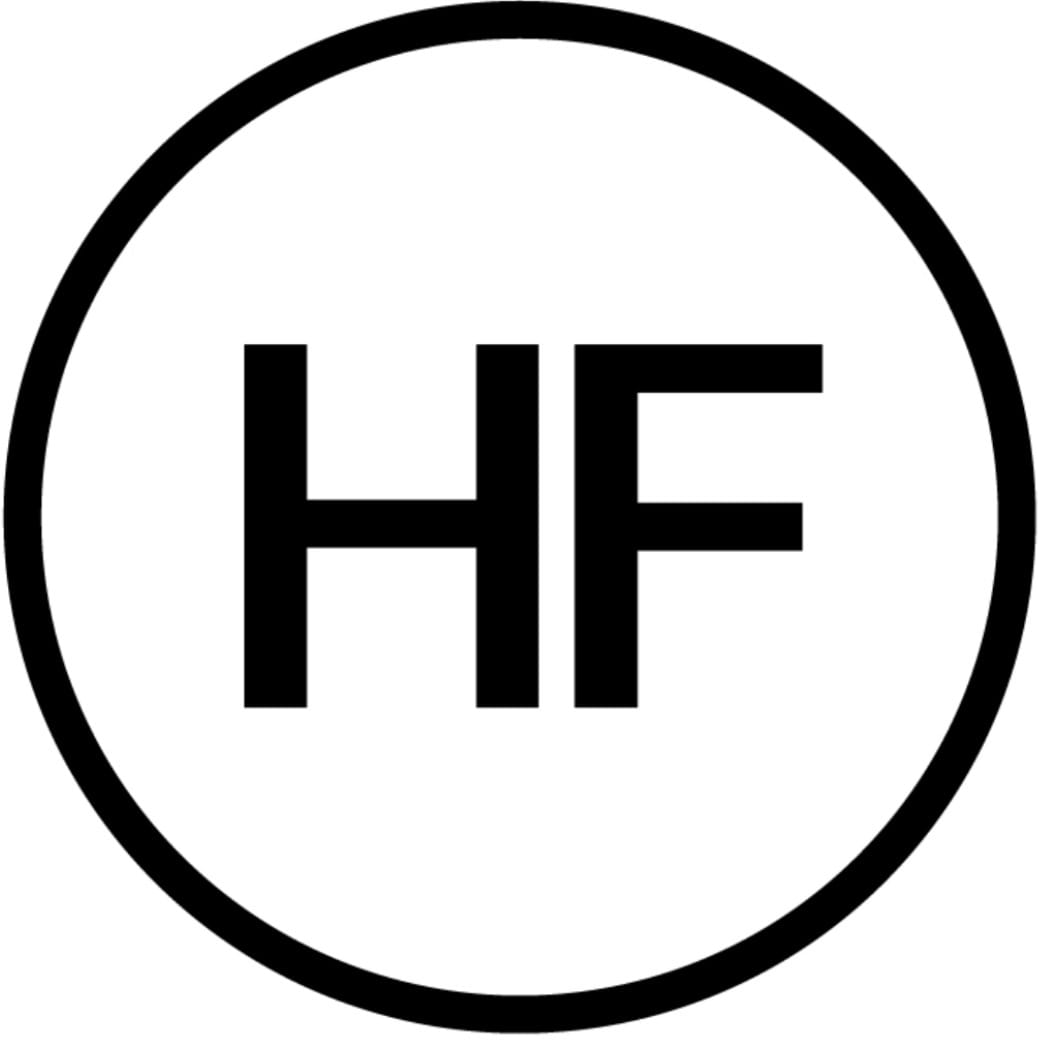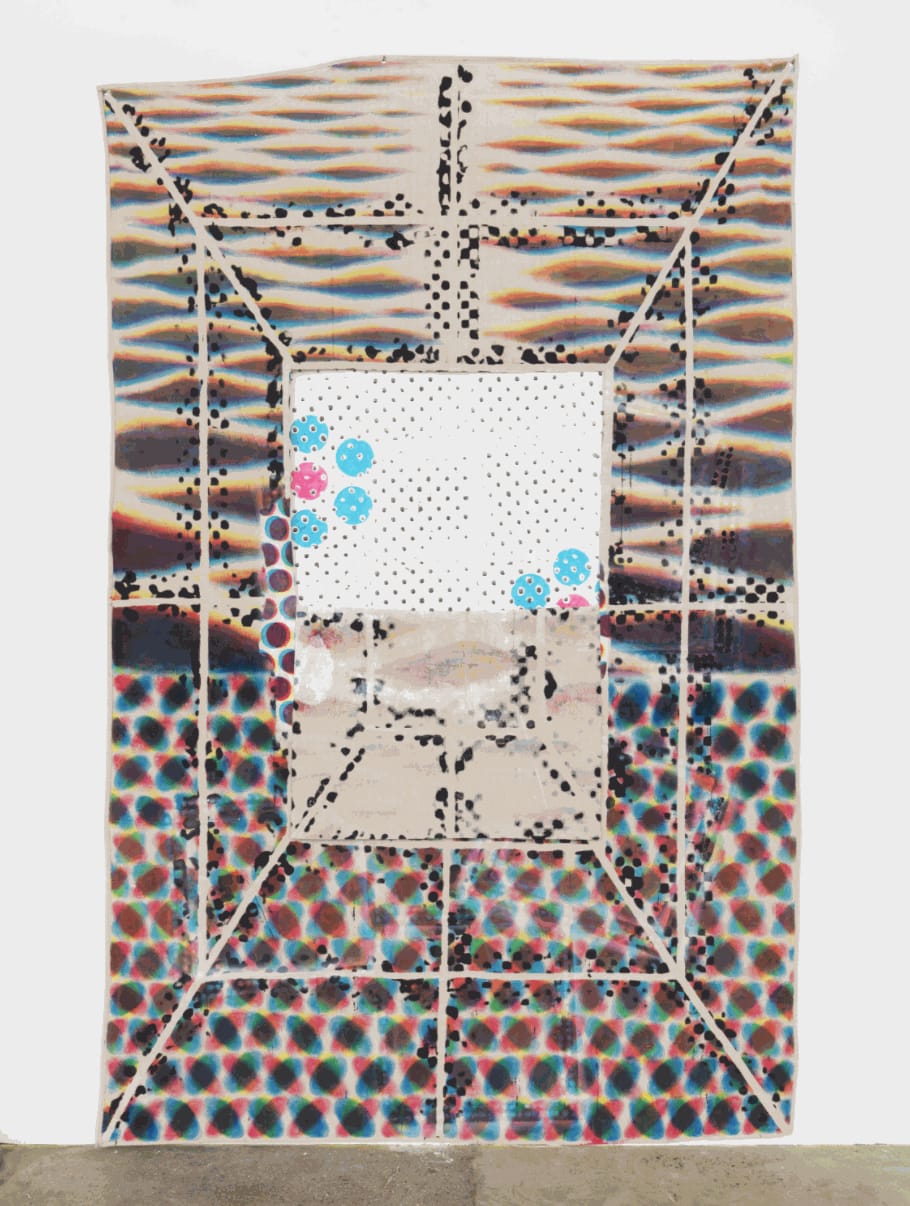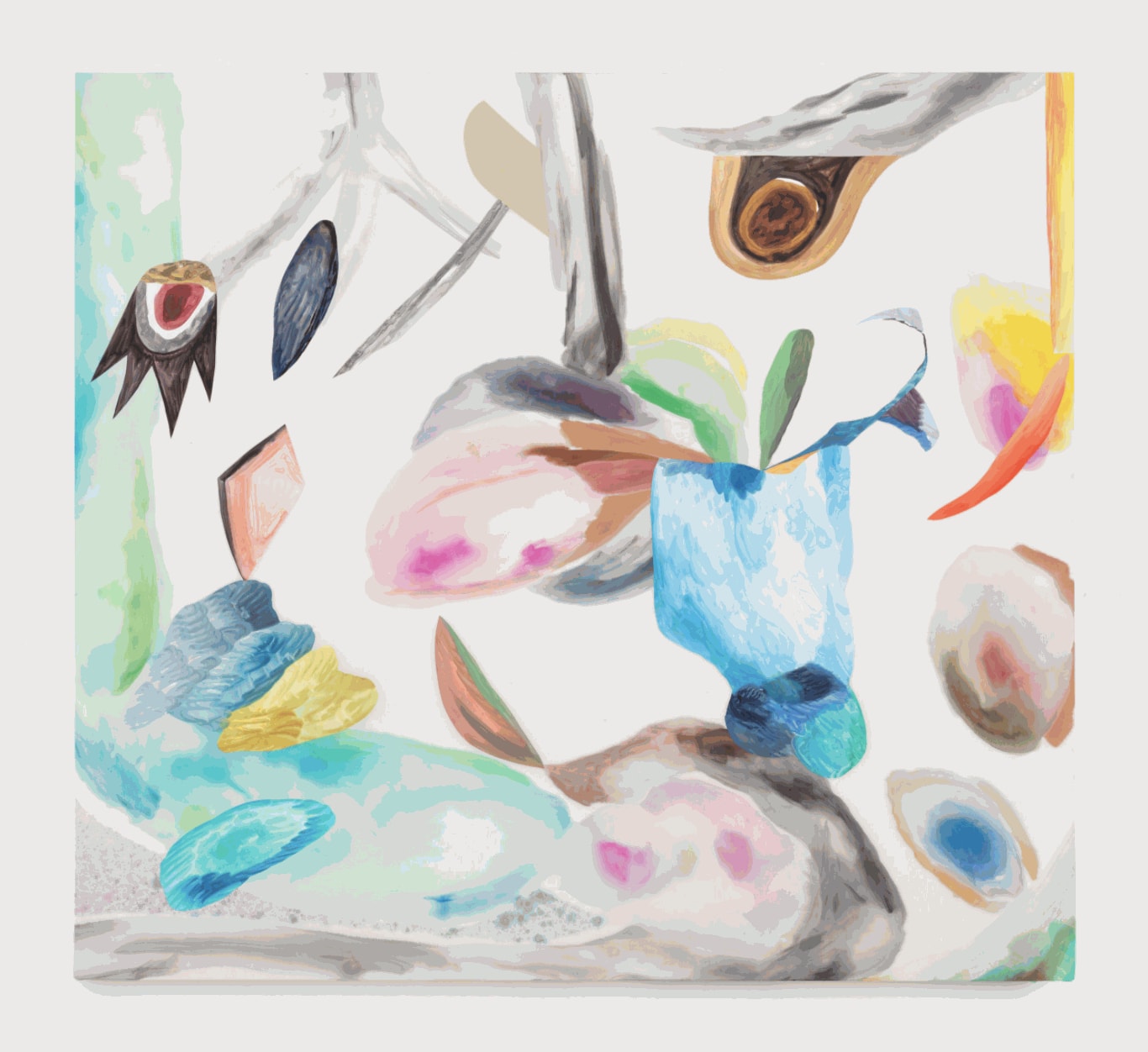Seeping, splashing, bleeding with color, dotting viewers’ eyes like gridded spurts of flashing sunspots, the works of Lauren Silva and Bill Komoski coat the walls of CRUSHCURATORIAL with disconcerting hues and strangely layered space. Komoski and Silva work in suggestive abstractions which, without referring to anything particular, recall landscapes and simplistic figures: a bare bust against the interpreted distance of a receding plane, botanical growths that seem to elongate and to become more robust before our eyes.
Characterized by their patterned, resonant screens, Bill Komoski’s paintings slide in focus between different layers of interlacing planes, falling deeper into the representational only to accelerate once more towards the texture of their surfaces. Incorporating networks of dots in an invocation of CMYK printing, Komoski uses these walls of sound to opposite effect of their popular counterpart, purposefully fraying rather than building the deeper, deceptive horizon in a continual reminder of material tactility.
Lauren Silva’s stained silks similarly reorient towards a sensual surface sheen, surprising the viewer with cut paper inclusions which disrupt the continuity of the painted plane. Although the works included in the show at CRUSHCURATORIAL are not originated digitally, there remain certain elements which recall an Adobe aesthetic from cascading scales of gradients to the clean cuts of computerized image editing. However, this slick quasi-digital play is complicated by Silva’s deliberate stains and fleshly marks.
Though composing in the painted medium, Komoski and Silva engage colors and aesthetics that become as a form of popular quotation where mode of representation itself becomes referential, materials responding to the slippery surfaces of automated or digital rendering.
In a conversation with Dona Nelson, Komoski and Silva discuss the materiality of their works and the development of the murals performed on the walls of CRUSHCURATORIAL.
Following is an excerpt of a conversation between Bill Komoski, Lauren Silva, Dona Nelson, and Nicole Kaack.
Nicole Kaack: Something that related to both of you was this idea of what gestures or technical apparatuses are influencing your work. A digital influence, for example, in the idea of the gradient. In your work, Bill, I see something more in the vein of printing, press, CMYK influence. I am curious what that means to the two of you and how that relates to the idea of painterliness in gesture.
Dona Nelson: [to Lauren] I would like to know, are these done on photoshop or…? How are they painted? Where do you get the image?
Lauren Silva: These works here were not done on photoshop. They are all hand-painted on silk. In my experience working on silk and one of the things that sort of drew me to it was, you can’t go back and change it. So with photoshop, with acrylic, on canvas, with oil, there is so much reworking and layering. But with the silk, what you see is what you get. I just wanted this delicate material — if you get a stain on it, you ruin it. And so the imagery really just grew out of gestures I was making and then responding to. Because I couldn’t go back…
Dona Nelson: Do you have any source or are you just working out of your head?
Lauren Silva: These were all worked out of my head, but are also all sort of natural forms. I love going to Central Park and I went to a lot of gardens over the summer; this became a meditation on these organic forms.
Nicole Kaack: Your earlier work, also had a lot of moments that potentially reflected landscape? But they also felt somewhat surreal, like they play on this uncertainly representational thing.
Lauren Silva: It is definitely touching on that same impulse. More of a surreal landscape.
Dona Nelson: And what kind of paint is this?
Lauren Silva: This is gouache and watercolor. Because they are already soaked into the [fabric], they won’t wash off. There are imperfections in it, built into the natural material, the natural process. Those types of imperfections become part of the image. In working on them, I did re-wet and found that the paint did not lift off.
Nicole Kaack: You kind of use that, though, the feeling of a stain at certain moments. Did you intentionally wash out areas?
Lauren Silva: I did. It’s silk charmeuse which is an intimate, very soft textured thing. I was drawn to this fabric because growing up I always fell asleep with my mom’s silk-charmeuse nightgown. And it was such an intimate material and I loved the feel of it. But then it’s your body, it gets stains on it. It was just this personal dimension that I wanted to try to use just as a starting off point to begin making marks and begin building a world.
Nicole Kaack: They are stretched before you start?
Lauren Silva: No, the cropping happens after the fact. Some of these were much larger and that area got cropped.
Bill Komoski: So, I guess all three of us kind of work with an improvisational approach? Do either of you work with preliminary sketches or have an idea before you start? I’m thinking not in Dona’s case. Do you? [to Lauren] You just go, right?
Dona Nelson: [to Lauren] But you must have a palette, before you start. Do you have the colors mixed?
Lauren Silva: I have a lot of colors on a paper palette. Working in other ways I would definitely mix all the colors, have a large quantity of it. With oil or with airbrushing or with acrylic, that was sort of standard process. Because so much of it is water-based, I don’t have to spend so much time— I can have more of a fast improvisation with working on things like gauche and watercolor, which don’t take up much room. I can have a lot on the same table.
Dona Nelson: But what about the big one [on the wall]?
Lauren Silva: This one, I did after I had already gotten into the flow of working on the small works. And that is the last one I did.
Bill Komoski: Have you done other wall installations? Directly on the wall drawings, paintings?
Lauren Silva: In undergrad and in grad school, I did more. I guess just because I was a student, and I was just burning through stuff, I often just went directly on the wall or would make giant wall-size works. This is the first public one here.
Nicole Kaack: It is only paint, right? There are no paper inclusions like you have used in other works?
Lauren Silva: This is just paint and I did tape off areas. The silk ones do have this really thin paper that is actually meant for t-shirt production. I was drawn to it because I could cut it out and have a straight edge similar to the way that taping allowed me to. It is a heat-activated, archival, ironed [adhesive]. So, I guess, going back to our original questions: I think it’s all of the experience working in these different realms, I kind of built this system. It sort of became it’s own thing — this combination of a straight edge with a more blurred image.
Nicole Kaack: Exactly, there is something digital in the way the paper operates. Or even in your work, as well, Bill. I wonder if —in the front room— that mural that you have done with the cloth draping over is a similar kind of straight edge, a different type of digital overlay or cut? Then again, it is also much more about the materiality.
Bill Komoski: When I started working on these drop-cloths,
they have a similar quality to the silk in that there is no turning back. They are stained and there is no painting over or playing around with them too much. So they have to just happen. With the one on the wall with the hole, I had no idea what that hole was going to bring. At some point, I just decided that I didn’t like it without the hole and something had to happen. I got the razor blade, I cut the thing, and I loved the way that suddenly the back was revealed, that the stain had come through. That this window opened up. There was already kind of a structure that had a framing element to it, and suddenly that frame opened up to a window. When this wall-drawing happened, the window allowed for the wall-drawing to re-emerge in the painting.
Dona Nelson: Is this silk-screen?
Bill Komoski: No, it is just painted directly on the drop-cloth. I buy these at the hardware store. They’re cut that way and edged and all. It’s block printing more or less, for the dot-screen. Old-fashioned block printing that goes back centuries.
Nicole Kaack: I think that is why I was curious to ask specially about your influence by technology. Not all technology is contemporary.
Bill Komoski: Well, I like the idea because there is this aspect of process involved with randomness and degraded systems, layers upon layers. A mess of patterns. A pattern like a grid which is also about uniformity and ordered space, seemed like a good element to bring into that mix. And to start with that and watch it unravel. These drop-cloth pieces are the least layered in a way. The smaller paintings tend to have more materiality to them, more layers on top of layers, evolving generally over a longer time, allowed to have things painted out and painted over. They are really different. The drop-cloths are closer to watercolors, where there is no erasure.
Dona Nelson: They are a nice size.
Bill Komoski: But the large one on the wall is also commercially-made. Those are the dimensions that they come in.
Dona Nelson: What kind of paint is on the wall?
Bill Komoski: Acrylic. Everything here is acrylic, except for the elements that aren’t paint. In the paintings there are a lot of found elements like fabric, synthetic rhinestones that I get at a party store in the flower district. But the paint is all brushed on. I’m pretty old-fashioned when it comes to actually applying the paint. All of the dots in the screen in the painting to the right are hand-painted. I don’t use any mechanical devices for that. It’s a little bit labor-intensive on the big ones, on the small ones not so much. There is something sort of meditative about that. And that is before things get fun, do you know what I mean? There is a certain pleasure in putting down something like that, but it is always a mode of investment that you then put at risk when you start to lay stuff on top of it. Maybe something drips. I like that kind of danger element that comes in after you’ve already put this investment in. And that is the way it usually goes in terms of the order of things.
Dona Nelson: It’s got this kind of hovering image.
Bill Komoski: Well there are elements of transparency and almost immateriality happening around the physicality. Play between delicacy and something very obviously material and dumb, just stuff, and then trying to liberate it from its sort of—
Dona Nelson: Obviousness.
Bill Komoski: Yes, obvious sort of materiality and allow it to float in some ambiguous space or create associative resonance around it. Around the stuff, beyond the stuff.
Dona Nelson: I am really interested in how there is no figure-ground in the work. In any of it. That is the idea of it; it implies a figure-ground but the figure is dissolving, like there is no edge.
Nicole Kaack: Or it comes back to the surface of it again.
Bill Komoski: Right, and you are constantly reminded that the surface is a real object, a thing. Even if the space opens up in terms of layering, there is always this emphatic quality to the surface re-asserting itself.
Nicole Kaack: I feel like that is true of all of your works really. This emphatic orientation towards the materiality.
Bill Komoski: The fact of the thing.
Nicole Kaack: And that there are suggestions of things that are deeper or more representational about the works, but it always rises up again to the experience — getting into that surface as a depth.
Bill Komoski: And I think that all of our work also has representational elements —even just in my work, the representation of printing or the representation of three-color separation and digital processes. Or now with this form that somehow emerged, that somehow seems head-like, this centralized element. It potentially refers outside of itself, but again we are back into the meat of the material. I think we all play with that back-and-forth.




